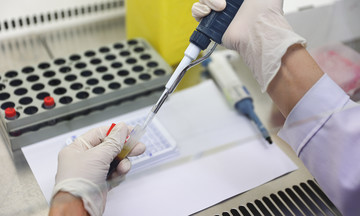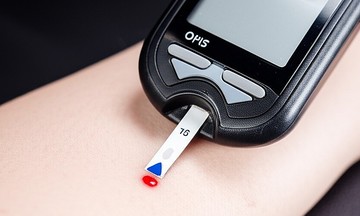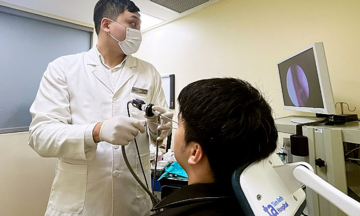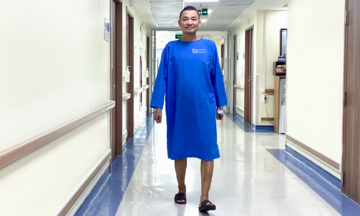Three years ago, a woman from Tay Ninh province was admitted to Gia Dinh People's Hospital with persistent poor appetite, difficulty urinating, abdominal pain, and distension. She had sought treatment at various facilities without success. Doctors at Gia Dinh People's Hospital diagnosed her with Budd-Chiari syndrome, a rare condition affecting only one in 2.5 million people.
Normally, blood flows through the liver and exits via the hepatic veins into the inferior vena cava, returning to the heart. In individuals with Budd-Chiari syndrome, this flow is obstructed, causing blockage in the hepatic veins. The liver gradually swells, becomes painful to the touch, and fluid leaks into the abdominal cavity, leading to ascites – a common symptom of the disease. Due to its non-specific symptoms, this syndrome is often misdiagnosed as other liver diseases. Accurate diagnosis requires liver function tests, ultrasound, and CT scans.
Thanks to early detection, doctors inserted a venous stent and administered anticoagulant therapy, stabilizing her condition. She resumed her normal life, got married, and conceived naturally. From the beginning of her pregnancy, a multidisciplinary team of doctors at the hospital worked closely together, adjusting her anticoagulant medication throughout each stage and monitoring the baby's development through ultrasound, Doppler vascular imaging, and regular checkups.
At 38 weeks, when doctors detected fetal growth restriction and reduced blood supply, they held a consultation and promptly stopped the anticoagulants to perform a cesarean section. Due to the synchronized efforts of the Obstetrics, Interventional Cardiology, Anesthesiology and Resuscitation, and Neonatal Pathology departments, the surgery was successful and safe. Immediately after delivery, the mother's anticoagulant therapy was restarted to prevent thrombosis and stent blockage.
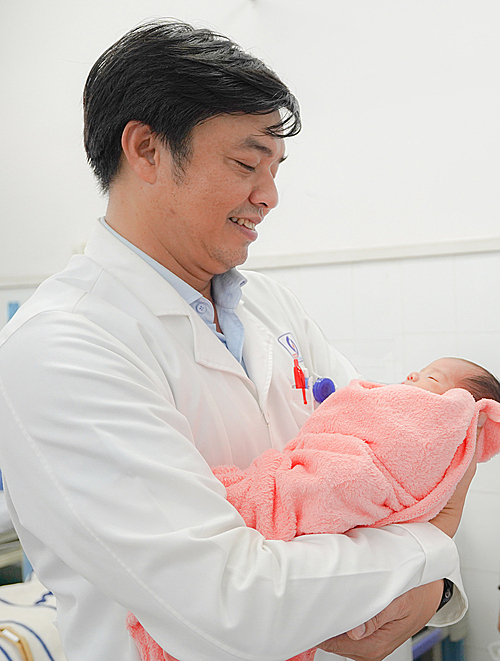 |
Doctor Ngo Minh Hung, who performed the C-section, holds the baby after birth. Photo courtesy of the hospital |
Doctor Ngo Minh Hung, who performed the C-section, holds the baby after birth. Photo courtesy of the hospital
On 25/8, Doctor Ngo Minh Hung, Head of the Obstetrics Department at Gia Dinh People's Hospital, stated that this was a very rare case. Pregnancy is a known risk factor for triggering Budd-Chiari syndrome due to the physiological increase in blood clotting. In women already diagnosed with the condition, pregnancy exacerbates the disease, posing a high risk of death if not stabilized. The rate of successful pregnancies and live births is very low, with only about 20-30% of women with chronic Budd-Chiari syndrome able to give birth, most requiring anticoagulants during pregnancy. The fetus is also prone to complications such as miscarriage, stillbirth, or intrauterine growth restriction.
Women with Budd-Chiari syndrome should only conceive when their condition is stable. During pregnancy, they require multidisciplinary consultations and examinations to assess liver and kidney function, blood clotting factors, and stent integrity through ultrasound. Anticoagulant medication is switched to low molecular weight heparin during pregnancy, and close monitoring of the fetus is conducted via ultrasound and tests. Before delivery, the medication is stopped at the appropriate time to avoid bleeding and restarted soon after birth to prevent thrombosis.
Overjoyed to witness her daughter's successful delivery, the new grandmother said that when her daughter was diagnosed, the family had lost all hope. Fortunately, the doctors provided treatment and closely monitored every step. "Holding my grandchild in my arms, I am deeply grateful to the medical team for bringing this miracle to our family," she said.
Le Phuong





